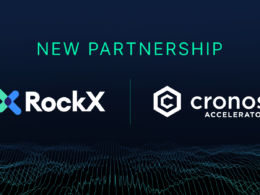Running a blockchain access node is a complex task that demands significant investment in terms of time, manpower, and resources. Understanding the intricacies of node security, uptime, and latency is critical for the successful implementation of any blockchain project. The use of nodes-as-a-service has therefore become increasingly popular as a more straightforward and more effective solution. RockX, a blockchain infrastructure company with extensive experience in setting up and operating blockchain nodes, has recently partnered with ARPA to enhance its node operation services.
ARPA, a network designed to be permissionless and accessible, continues to work closely with partners like RockX to round out its node architecture. This ensures the network is fully prepared to transition into a completely permissionless state, allowing the community to safely benefit from network openness and expansion via staking and node delegation, while also providing potential node operators with valuable insights from seasoned professionals like RockX.
For those seeking to set up their own nodes or simply to understand more of the challenges behind setting up blockchain nodes, these are some of the challenges associated with this endeavor.
Current Challenges in Setting Up Blockchain Nodes

Setting up access nodes requires a substantial investment of time, resources, and expertise. As part of the development process, developers must navigate the complexities of configuring and deploying nodes, ensuring compatibility with the specifications of the blockchain. Furthermore, extensive User Acceptance Testing (UAT) is crucial to establish stability and reliability, verifying that the nodes operate smoothly within the network. For instance, developers need to test for performance parameters such as latency, transaction throughput, and block propagation times, to ensure that the nodes are functioning optimally. Ideally, the nodes should be able to support the scale of any project that is built on top of it, ensuring high availability and security as well as low latency data transfer. Coding this will require a great deal of time and may require a number of iterations in order to get it right.
Upon establishing the nodes, it is important to keep them maintained in order to protect user assets or prevent other forms of attack. A robust security strategy is essential given the risks and vulnerabilities in the blockchain landscape. Blockchain technology vulnerabilities include problems with scalability, privacy, immutability, and decentralization. These can be addressed by employing strong security measures such as data encryption, secure access control, and monitoring of the nodes. Developers need to implement stringent security protocols to protect the integrity of the nodes. This includes employing advanced encryption techniques, establishing secure communication channels, and regularly updating software to stay ahead of emerging threats. Developers must be proactive in identifying and addressing potential vulnerabilities. For access nodes to perform reliably, continuous monitoring and defensive measures are essential.
The purpose of an access node should not be limited to supporting a single function in a single project; instead, it should offer seamless integration capabilities to help ensure a smooth implementation process. Node providers such as RockX offer a customizable solution that can be tailored to your specific needs and easily integrated into your existing infrastructure.
Evolving Challenges
As technology advances, new challenges arise for access node operators. The constant evolution of technology exposes networks to increased attack risks, necessitating robust security measures and constant vigilance. Additionally, fluctuating transaction volumes pose scalability challenges, requiring access nodes to adapt to varying workloads efficiently. Meeting higher expectations regarding data security, transparency, and cost efficiency further adds to the complexity of running access nodes.
Additionally, developers should ensure their access nodes are supported by a reliable and sustainable infrastructure. Recent blockchain upgrades have resulted in some node operators experiencing prolonged downtime. When downtime occurs, significant disruptions can occur and tremendous financial losses may ensue, which makes maintaining a high uptime level essential. Auto-failover setups and WebSockets enhance reliability, providing uninterrupted operation even under unforeseen circumstances. Backup nodes should also be included in the setup to ensure optimal uptime. Regular maintenance should be performed to ensure that all nodes are running correctly. Further, regular testing should be done to ensure the network can handle any load or unexpected events. In the rapidly evolving blockchain ecosystem, being able to quickly adapt to new blockchains and configure nodes is crucial.
Engaging a Node Provider

When engaging a credible node operator, developers, and project managers must carefully evaluate several factors:
- Shared vs. Self/Local Node: Weigh the benefits and drawbacks of using shared nodes or setting up their own local nodes, considering factors such as control, security, scalability, time and manpower cost, and more as mentioned above. Shared nodes are typically more cost-effective as they are maintained by the provider and require little time and energy to set up and manage. However, there needs to be more control over the data and security of the nodes as they are shared with other users. Local nodes, on the other hand, offer more control, security, and scalability as they are managed solely by the user. However, they require a lot more time and effort to set up and manage, and the cost associated with the hardware and software is much higher.
- Mitigating Slashing Possibilities: Seek node operators that provide robust measures to mitigate slashing risks, safeguarding their staked assets. This might include using a secure wallet, setting up a secure node, and keeping validator keys safe. Additionally, it’s important to pick a node operator that offers reliable support and customer service.
- Cost Efficiencies: Explore competitive packages offered by various node operators, considering factors such as pricing, value-added services, and ongoing support. Running your own blockchain node can prove expensive due to the high cost of hardware, software, and hosting. Therefore, it is essential to evaluate the options carefully to find the best solution for your specific needs. Node operators like RockX offer highly scalable and flexible plans that can help reduce costs and ensure reliable network performance.
- Flexibility and Customization: Find node operators that offer flexibility in supporting new blockchains, enabling quick integration within days rather than weeks. Consider the possibility of your project expanding cross-chain, and the node provider’s availability on various blockchains.
- Reliability and Performance: A node operator’s track record of reliability, with a high uptime percentage and auto-failover mechanisms, is crucial to ensure uninterrupted access to the network. Performance also matters. The node should have high throughput and low latency, with the ability to process and validate transactions quickly. Furthermore, a node should be able to scale up or down based on the market’s demand.
- Working with credible network partners: Working with credible network partners necessitates a careful balance between convenience and control, weighing factors like cost, scalability, and security in the choice between shared and local nodes. It’s crucial to select partners that can mitigate slashing risks, offer cost-efficient services, and provide quick and effective support for new blockchains. The ideal partner will also demonstrate a strong track record of reliability and high performance, capable of quickly processing transactions and scaling in response to market demand. Successful partnerships, like that of RockX and ARPA, embody these principles, yielding improved network infrastructure performance and enhanced security.
Conclusion
It can be challenging to ensure a stable and reliable operation of access nodes on blockchains. Technology is evolving at a rapid pace, and the increasing expectations of users require constant adaptations and robust security measures. By considering factors such as seamless integration, customization options, reliability, and security, developers can engage credible node operators that provide a solid foundation for their blockchain projects.
Ultimately, the goal is to foster a more robust, secure, and flexible blockchain infrastructure that propels these projects toward successful implementation and growth. The successful collaboration between RockX and ARPA sets a noteworthy example in this regard, demonstrating the potential for enhanced network performance and security through strategic partnerships.
Read next: Types of Nodes in the Blockchain Explained









